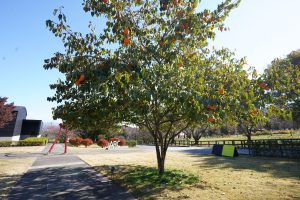Contents
Special
Revive Time: Kaki Tree Project: Celebrating 20 Years of Planting Kaki Trees

Revive Time: Kaki Tree Project–Second-Generation Atomic-bombed Persimmon Trees
This project began with a kaki (persimmon) tree that miraculously survived the atomic bombing of Nagasaki on August 9, 1945. When artist Tatsuo Miyajima came across a sapling from a “second-generation kaki tree” that was born from the mother tree, he conceived of a project that would distribute saplings to children around the world for them to raise, and in so doing, learn about the importance of peace and life while expressing themselves through art on the theme of kaki trees. Art cultivates our imagination, allowing us to feel the pain of others, and creativity to build a new world. It goes beyond borders, religion, race and even language to enable us to feel sympathy for each other. The purpose of the project resonated with Hara Museum ARC which adopted a tree.
Celebrating 20 Years of Planting Kaki Trees
In the spring of 2005, the first kaki sapling was planted in Gunma prefecture as part of the Revive Time: Kaki Tree Project at Hara Museum ARC. In 2025, the tree celebrated 20 years of robust growth. Art events were held at the museum in connection with the tree: in 2004, the year before the tree was planted; in 2005 when the tree was planted; and in 2014, on the 20th anniversary of the project itself. These three art events, which are a part of the tree’s history, are described below. The purpose of the events was to provide happy memories to children that would encourage them to remember the second-generation atomic bombed kaki tree.*
*Reference: Official website of the Revive Time: Kaki Tree Project.
Revive Time: Kaki Tree Project Events Held at Our Museum Up to 2024
November 6, 2004 Pre-Event
This was a two-part pre-event that was held prior to the planting of the sapling.
In Part 1, lecturer Anken Kidani explained the Revive Time: Kaki Tree Project through a picture-story show. In Part 2, participants created a mural of a kaki tree by attaching leaves and fruit to the trunk of a tree painted on the wall of one of the galleries. About 50 people participated consisting mainly of students from Gunma prefecture elementary schools, but also including on-lookers, families and students from the Faculty of Education at Gunma University. An exhibit of materials from the Revive Time: Kaki Tree Project, including the mural, was on public display until January 10, 2005.
May 14, 2005: The Planting of the Tree and Then…
The tree planting event was held in three parts.
In Part 1, a lecture, Let’s talk with the ‘Tree Doctor,” was given by tree doctor Ebinuma Masayuki who treated the parent tree that had been exposed to the atomic bomb and produced the second generation of saplings, and Koike Nobuo, who has supported his activities.
In Part 2, in the workshop Let’s All Take on the Challenge of ‘Regeneration’ – from Tree to Tree, participants worked with Tatsuo Miyajima, the originator of the Revive Time: Kaki Tree Project, to create a “regenerated tree” with branch trimmings from the neighboring Ikaho Green Bokujo to which foliage made of construction and colored paper was attached to make the tree “bear” fruit.
In Part 3, in the workshop To the Future – Planting Second-Generation Kaki Trees, we carried out the planting of a second-generation sapling of the atomic bomb survivor on the grounds of the museum.
November 1, 2014: Kakimawasu
To commemorate the 20th anniversary of the launch of the Revive Time: Kaki Tree Project, artist Yuta Nakajima (from Gunma prefecture) held an event in which he collected fruit from second-generation atomic bomb survivor kaki trees planted in various places to make charcoal, and then use the charcoal in a workshop that he held.
On the day of the event, participants joined the artist to grind the charcoal to make sumi ink. They then circled around the tree drawing pictures of the tree and pretending to be shadows to convey the passage of time. Project originator Tatsuo Miyajima was also in attendance.
And from now…
 Last Year’s (2024) Kaki Fruit
Last Year’s (2024) Kaki Fruit
Our museum’s second-generation atomic bombed kaki tree produces plump persimmons every year, a delightful sight to our visitors. How many will it bear this autumn in 2025? Please look forward to it!
(June 2025)
Related Information
Revive Time: Kaki Tree Project Official Website
About Parent Tree of the Sapling(PDF)